¶ Introduction
The aerodrome traffic circuit is defined as a special pattern (standard or non-standard) that is used by traffic to fly to and away from the runway in use at an airfield.
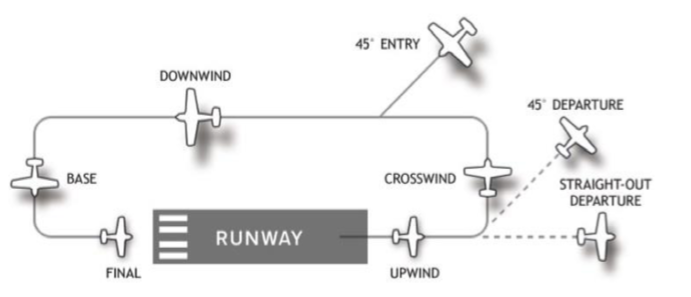
The tower controller is responsible for the traffic flow that goes through the traffic pattern. He has an important role at the airport operation; his position will guarantee a proper sequencing of the arrivals and the relation with the departures. All of these manoeuvres will affect the efficiency and safety of the active runways and the aerodrome.
¶ Circuit overview
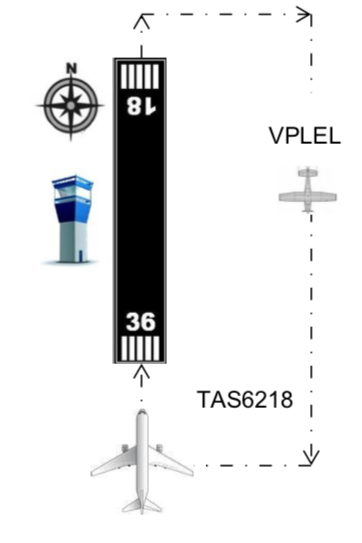
In this document, we will use
- a runway 18/36 with a tower controller:
- There is a right hand aerodrome traffic circuit runway 36.
- Runway in use is 36 for take-off and landings.
- The airfield is in class C, D or E airspace.
In this aerodrome, you can find:
- VFR flight using C172 like VPLEL
- IFR flight using A330 like TAS6218
¶ Arrival management -- how to integrate into the circuit
A clearance shall be given to any pilot who wants to enter into the aerodrome traffic circuit. It is important to be aware about the conditions to give a clearance to join the traffic circuit.
An aircraft shall not enter into the aerodrome traffic circuit without a clearance if there is an active ATC operating and giving air traffic control service.
The radio contact between aircraft and tower controller shall be initiated by the pilot before beginning any entry of an aerodrome traffic circuit even if the associated class of space (like a control zone) does not require a preliminary radio contact.
The aircraft in the aerodrome circuit have priority over other aircraft outside the circuit. The entry could be possible in several manners:
- From the beginning or from the middle of the downwind leg
- Semi direct entry in base leg
- Direct entry in long final
¶ Downwind entry
The first possibility of aircraft integration into the circuit is to integrate it on downwind leg.
In function of the position of the aircraft, you can instruct the aircraft to join at the beginning or at the middle of the downwind leg.
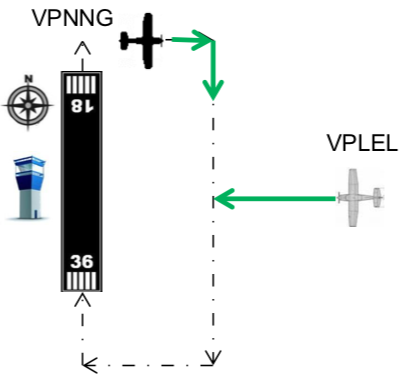
Example with no traffic in the circuit (No VPNNG):
- 📡 VPLEL, join right hand downwind runway 3 6, report downwind
- 🛩️ Joining right hand downwind Runway 3 6, will report downwind, VPLEL
Example with an aircraft already on crosswind leg in the aerodrome circuit:
- 📡 VPLEL, join middle of right hand downwind runway 3 6, Cessna 1 7 2 on crosswind leg, report downwind
- 🛩️ Joining middle of right hand downwind Runway 3 6, traffic in sight, will report downwind, VPLEL
- 📡 VPNNG, traffic, Cessna 1 7 2 from East airfield to downwind
- 🛩️ Traffic in sight, VPNNG
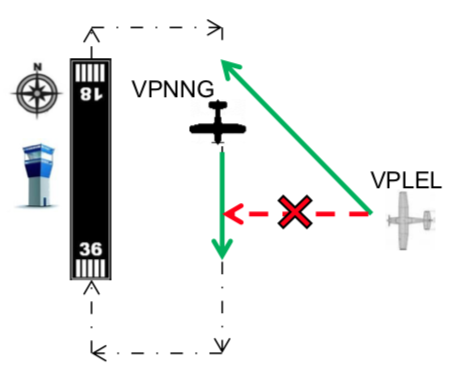
Example with an aircraft already on downwind leg in the aerodrome circuit. Instruction to join middle of downwind leg shall not be given to VPLEL due to the fact that he will join the middle of downwind with possible separation conflict with VPNNG:
- 📡 VPLEL, join beginning of right hand downwind runway 3 6, number 2 behind Cessna 1 7 2 at your 1 o'clock, established on downwind runway 3 6, report traffic in sight
- 🛩️ Will join beginning of right hand downwind Runway 3 6, number 2, traffic in sight, will report downwind, VPLEL
- 📡 VPNNG, traffic at your 10 o'clock, Cessna 1 7 2 from east airfield to beginning of right hand downwind
- 🛩️ Traffic in sight, VPNNG
Traffic information is always mandatory between VFR flights to ensure their own separation in the aerodrome circuit, in class C, D, E airspace.
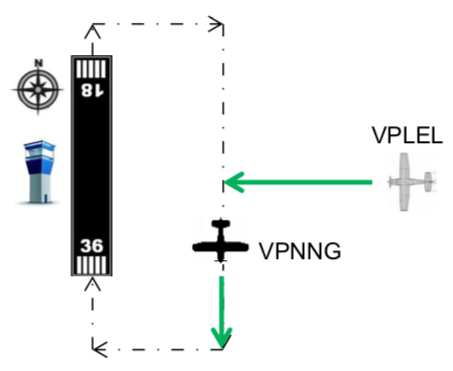
Example with an aircraft already on downwind leg in the aerodrome circuit but enough separation is available to integrate the aircraft VPLEL at the middle of downwind.
- 📡 VPLEL, join middle of right hand downwind runway 3 6, number 2 behind Cessna 1 7 2 at the end of downwind runway 3 6, report downwind
- 🛩️ Will join middle of right hand downwind Runway 3 6, number 2, traffic in sight, will report downwind, VPLEL
Note: At this stage, it is not necessary to give traffic information to aircraft VPNNG as the other aircraft will join the circuit behind him. (pilots can't look behind their aircraft)
¶ Base entry
Another possibility of aircraft integration into the circuit is to integrate it on base leg. This is sometime called a "semi-direct approach" in some countries.
This clearance allows shortening the trajectory of the aircraft which are in a sector closer to the base than to the beginning of the downwind branch.
However, because of the complexity of the traffic either to optimize or simplify the sequence, the controller remains free to propose or to refuse a semi direct approach.
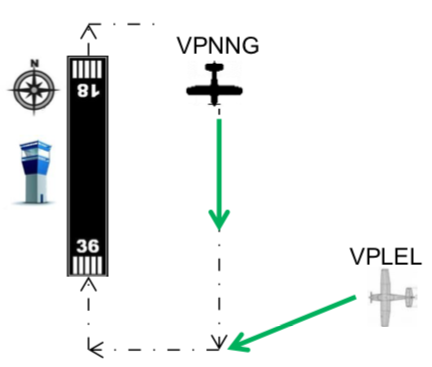
Example with no traffic in the circuit (no VPNNG):
- 📡 VPLEL, join right hand base runway 3 6, report on final
- 🛩️ Will join right hand base Runway 3 6, will report on final runway 3 6, VPLEL
Example with an aircraft already on downwind leg in the aerodrome circuit:
- 📡 VPLEL, join right hand base runway 3 6, Cessna 1 7 2 on downwind leg, report on final
- 🛩️ Will join right hand base runway 3 6, traffic in sight, will report on final, VPLEL
- 📡 VPNNG, traffic, Cessna 1 7 2 from East airfield to right hand base runway 3 6
- 🛩️ Traffic in sight, VPNNG
In the example above, pay attention that the aircraft VPLEL will arrive first on base with enough separation. In the example below, the integration on base is impossible; the aircraft VPLEL will join at the same time as aircraft VPNNG. Since VPNNG is already in the aerodrome circuit, he has priority.
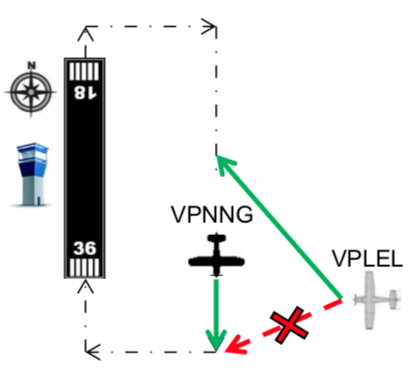
Example with an aircraft already on downwind leg in the circuit. Instruction to join base leg shall not be given to VPLEL:
- 🛩️ Tower, request circuit integration on base runway 3 6
- 📡 VPLEL, Negative, Cessna 1 7 2 at the end of downwind leg, number two behind, join middle of downwind runway 3 6
- 🛩️ Number 2, will join middle of downwind runway 3 6, traffic in sight VPLEL
- 📡 VPNNG, traffic at your 10 o'clock, Cessna 1 7 2 from east airfield to middle of downwind runway 3 6
- 🛩️ Traffic in sight, VPNNG
With that instruction, you leave the incoming aircraft manage its own separation behind the aircraft already in the aerodrome circuit.
¶ Straight-in Approach
Another possibility of aircraft integration into the circuit is to integrate it on final leg. This is called a "straight- in approach".
This clearance allows shortening the trajectory of the aircraft which are in a sector closer to the runway axis (angle not more than 30°) than to the base leg or downwind leg.
However, because of the complexity of the traffic either to optimize or simplify the sequence, the controller remains free to propose or to refuse a semi direct approach.
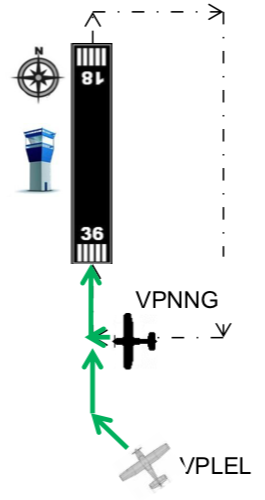
Example with no traffic inside the circuit:
- 📡 VPLEL, make straight-in approach runway 3 6, report on final
- 🛩️ Will make straight-in approach runway 3 6, will report on final, VPLEL
Example with an aircraft already on base leg:
- 📡 VPLEL, make straight-in approach runway 3 6, number 2, traffic preceding, Cessna 1 7 2 on base, report final runway 3 6
- 🛩️ Will make straight-in approach runway 3 6, traffic in sight, will report final, VPLEL
- 📡 VPNNG, number one, traffic, Cessna 1 7 2 from southeast airfield to final, report final runway 3 6
- 🛩️ Will report final runway 3 6, traffic in sight, VPNNG
In the example above; pay attention that the aircraft VPLEL will arrive on final first. In the example below, the integration on final is impossible; the aircraft VPLEL will join at the same time as aircraft VPNNG. Since VPNNG is already in the aerodrome circuit, he has priority.
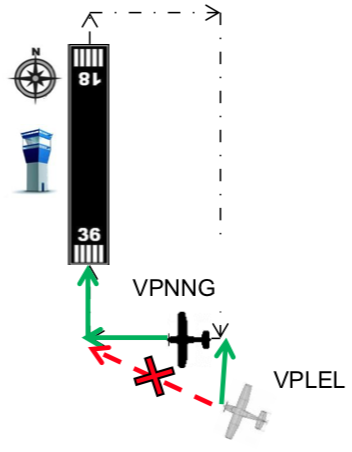
Example with an aircraft already on base leg in the circuit. Instruction to join final leg shall not be given to VPLEL:
- 📡 VPLEL, join right hand base runway 3 6, number 2, behind Cessna 1 7 2 on base, report final
- 🛩️ Will join right hand base leg runway 3 6, traffic in sight, will report final, VPLEL
- 📡 VPNNG, number 1, traffic at your 8 o'clock, Cessna 1 7 2 from southeast airfield to right hand base runway 3 6, report final runway 3 6
- 🛩️ Number one, will report final runway 3 6, traffic in sight, VPNNG
Note: In addition to the current situation, the aircraft VPLEL position is also not favourable to make a straight-in approach.
¶ Integration on other hand of the circuit
The air traffic controller has the authority to use the other side of the airfield without a published aerodrome circuit.
He can use it if there are no constraints like regulations, noise reduction, prohibited or restricted areas:
- for avoiding traffic in the main aerodrome circuit (overcrowded legs)
- for integration sequence optimization (separation of slow aircraft from fast aircraft; save fuel, distance and/or time)
- for simplification of integration (prevent a runway overfly)
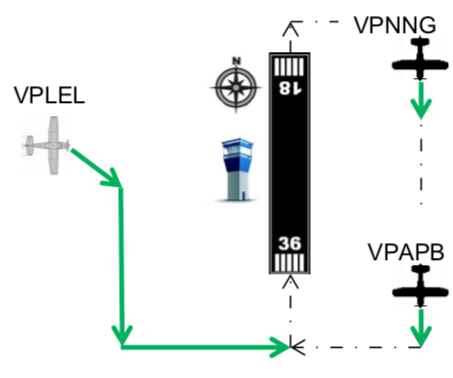
Example with two aircraft already on downwind leg in the aerodrome circuit :
- 📡 VPLEL, join middle of left hand downwind runway 3 6, traffic information, one Cessna 1 7 2 at the end of right hand downwind runway 3 6, another Cessna 1 7 2 at the beginning of right hand downwind runway 3 6, report left hand downwind
- 🛩️ Will join middle of left hand downwind Runway 3 6, number 2, both traffic in sight, will report left hand downwind, VPLEL
Note: At this stage, it is important to specify for each aircraft the aerodrome traffic leg and his hand where he is at present, as there are many cases of confusion.
¶ Integration from opposite side of the circuit
If the arriving aircraft is on the other side of the aerodrome circuit, this aircraft should cross the runway axis before joining the aerodrome circuit downwind.
This crossing operation should be done with providing traffic information if there is any traffic on the runway, on final or in the aerodrome circuit.
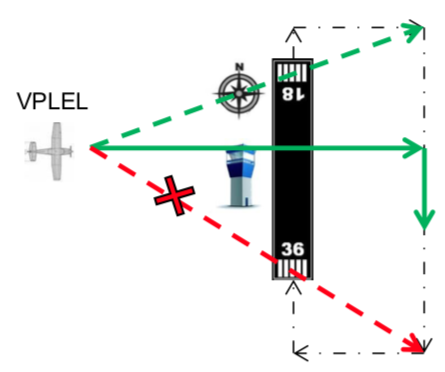
Example with one aircraft :
- 📡 VPLEL, join middle of right hand downwind runway 3 6, via over airfield, report left hand downwind
- 🛩️ Will join middle of left hand downwind Runway 3 6, via over airfield, will report left hand downwind, VPLEL
Note: In this configuration, a direct integration on final or on base is not operational.
¶ Traffic handling technique in aerodrome circuit
The tower controller should be able to handle the traffic (several aircraft) at the aerodrome circuit; it is really important for him to be familiarized with the aerodrome procedures and the local regulations.
¶ One aircraft in the aerodrome circuit:
In order to manage the VFR flights inside the aerodrome circuit, the tower controller will use the downwind leg report and final position report.
The crosswind leg report and the base leg position report are facultative. They are used only when necessary. The main reason for not using them is that these legs are very short and the pilot will go to the next leg in a short period of time. There is no reason to have 2 position reports in a short period of time: it is unwanted frequency messages that increase the tower controller workload with no additional value.
The goal of downwind report for a tower controller is to know when the aircraft will be in parallel direction of the runway. The aircraft will be stable at constant altitude, heading and speed. That implies that traffic on downwind leg will not be an obstacle for the runway landings and taking-off.
The goal of final report for a tower controller is to know that the aircraft is on final, stabilized and in configuration to land and ready to get the landing clearance.
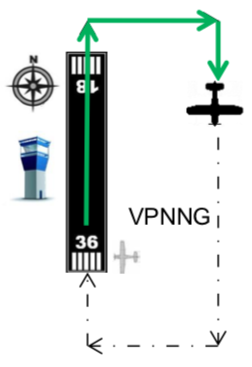
Example with one aircraft at holding point:
- 📡 VPNNG, line-up runway 3 6, cleared for take-off winds 020° 6KT, report right hand downwind runway 3 6
- 🛩️ Lining-up runway 3 6, cleared for take-off, report right hand downwind runway 3 6, VPNNG
After a while, when the aircraft reaches the next position (black aircraft):
- 🛩️ Right hand downwind runway 3 6, VPNNG
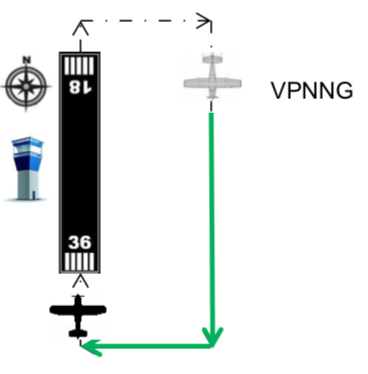
Example with one aircraft on downwind leg:
- 📡 VPNNG, report on final runway 3 6, number one
- 🛩️ Will report on final runway 3 6, number one, VPNNG
After a while, when the aircraft reaches the next position:
- 🛩️ On final runway 3 6, VPNNG
- 📡 VPNNG, runway 3 6 cleared to land, winds 020° 6knots
- 🛩️ Runway 3 6 cleared to land, VPNNG
Note: The tower controller can use "touch and go", "low pass" and "stop and go" clearances instead of landing clearance.
¶ Two VFR aircraft in the traffic circuit
With only one aircraft, the management is simple. But when there is more than one aircraft, the situation is not so simple. The aerodrome shall use traffic information as separation method in an aerodrome circuit (class C, D, E airspace).
Traffic information is important in order to achieve proper separation.
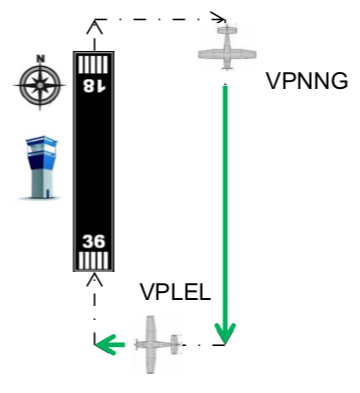
Example with two aircraft on aerodrome circuit:
- VPLEL is on base runway 36
- VPNNG just turns on downwind runway 36
- 🛩️ Downwind runway 3 6, VPNNG
- 📡 VPNNG number 2, follow Cessna 1 7 2 on base, report end of downwind runway 3 6
- 🛩️ Number 2, traffic in sight, will report on end of downwind runway 3 6, VPNNG
In the above clearance, VPLEL has to report on final runway 36. So, the tower controller lets this aircraft turn to final. It is of no use giving traffic information due to traffic behind him.
There is no need to give traffic information to an aircraft about another aircraft behind him, except during overtaking manoeuvres (for example: traffic at 5, 6 or 7 o'clock).
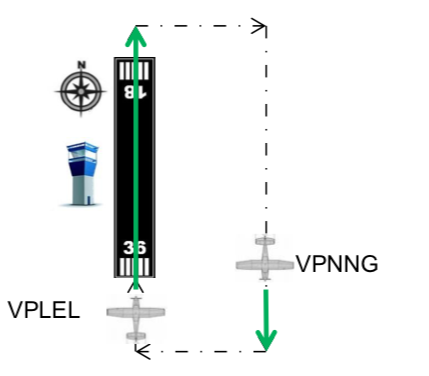
- 🛩️ Final runway 3 6, VPLEL
- 📡 VPLEL runway 3 6 cleared touch and go, wind 010 degrees 6 knots, report right hand downwind runway 3 6
- 🛩️ Runway 3 6 cleared touch and go, will report on right hand downwind, VPLEL
No traffic information to give to VPLEL as traffic will be behind him during its touch and go.
- 🛩️ Approaching end of downwind runway 3 6, VPNNG
- 📡 VPNNG, number 2, report on final runway 3 6
- 🛩️ Number 2, will report on final runway 3 6, VPNNG
No need to repeat the traffic information. The aircraft VPNNG doesn't lose the visual during his downwind leg. The "number two" is given to confirm that he is number two for landing and must pay attention to maintain enough separation with the traffic ahead.
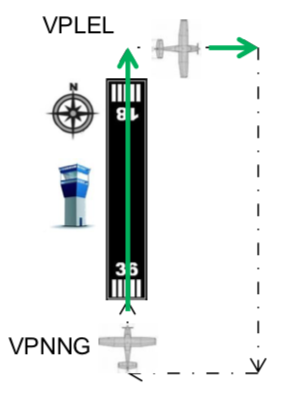
- 🛩️ Final runway 3 6, VPNNG
- 📡 VPNNG runway 3 6 cleared to touch and go, wind 010 degrees 6 knots, report right hand downwind runway 3 6, traffic Cessna 1 7 2 on right hand crosswind leg
- 🛩️ Runway 3 6 cleared to touch and go, will report right hand downwind runway 3 6, traffic in sight, VPNNG
¶ One VFR and one IFR (Mixed Traffic)
The tower controller will find several aircraft throughout daily operation: IFR aircraft could get mixed with VFR traffic established in the aerodrome circuit.
With IFR traffic, the tower controller will face many types of aircraft from the lightest aircraft (like Cessna 172 or Piper J3) to the heaviest aircraft (like Boeing 777, 747 or Airbus 330, 380).
The tower controller must apply sufficient separation between all landing traffic in function of the wake turbulence category of preceding aircraft.
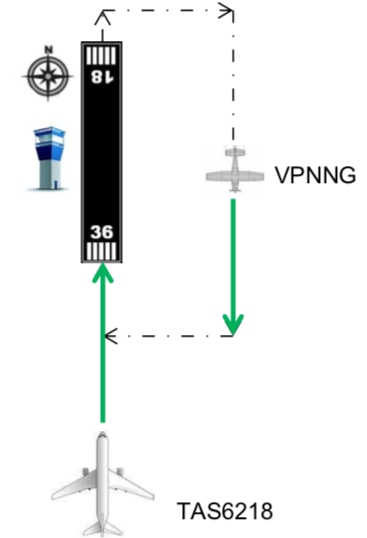
Example with two aircraft:
- TAS6218 is final runway 36 at 4NM DME
- VPNNG on downwind runway 36
- ✈️ Tower, Lotus Flower 6 2 1 8, established ILS runway 3 6, 4 NM final
- 📡 Lotus Flower 6 2 1 8, number one, traffic Cessna 1 7 2 on right hand downwind, runway 3 6 cleared to land, wind calm
- ✈️ Number one, traffic in sight, runway 3 6 cleared to land
To ensure separation, traffic information to the VFR aircraft is mandatory:
- 📡 VPNNG, number two, traffic Airbus 3 3 0 long final runway 3 6, report end of downwind runway 3 6
- 🛩️ Will report end of downwind runway 3 6, traffic in sight, VPNNG
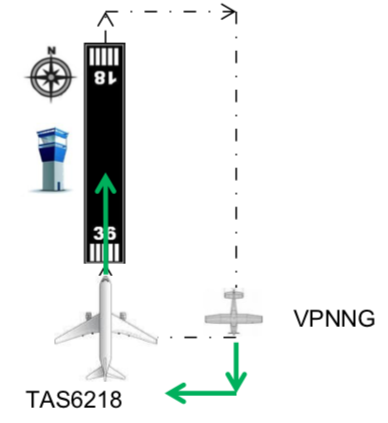
After a while, there is the new situation:
-
The A330 is cleared to land no further clearance needed for this aircraft
-
The C172 is on downwind leg, we expect his call back or tower controller can give integration instruction before position report like the example.
-
📡 VPNNG, number 2, behind Airbus 3 3 0 short final runway 3 6, report final runway 3 6
-
🛩️ Number 2, Will report final runway 3 6, VPNNG
Note: With this instruction, aircraft VPNNG shall take his base leg with enough separation with preceding traffic through a little extension of the downwind leg. Tower controller shall take this separation manoeuver into account when giving control instructions.
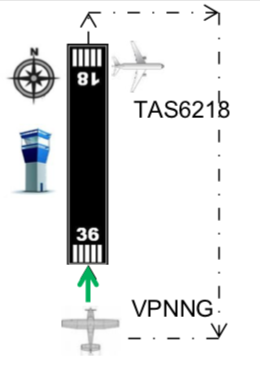
After a while, there is the new situation:
- The A330 has just vacated the runway
- The C172 is on final
- ✈️ Lotus Flower 6 2 1 8, runway 3 6 vacated
- 📡 VPNNG, runway 3 6, cleared to touch and go, wind 010° 7 knots
- 🛩️ Runway 3 6, cleared to touch and go, VPNNG
- 📡 Lotus Flower 6 2 1 8, taxi gate 5
Note the message priority :
Give the instruction to the aircraft which uses the runway first (landing, taking-off)
Then give the instruction to the aircraft flying
Then give instruction to the aircraft on ground at the end.
¶ Extend downwind instruction
In case of IFR arrival sequence at short distance, the tower controller cannot integrate the VFR flight without taking the risk of an IFR go-around (which can imply extra fuel cost for a company). In case of sequence with 1 to 3 IFR maximum, the tower controller can use the downwind extension.
Pay attention to the fact that this type of clearance shall imply the possibility to any VFR to enter in this area. Sometimes due to restricted/forbidden zones, big cities areas, or regulation constraints, this type of manoeuver is forbidden.
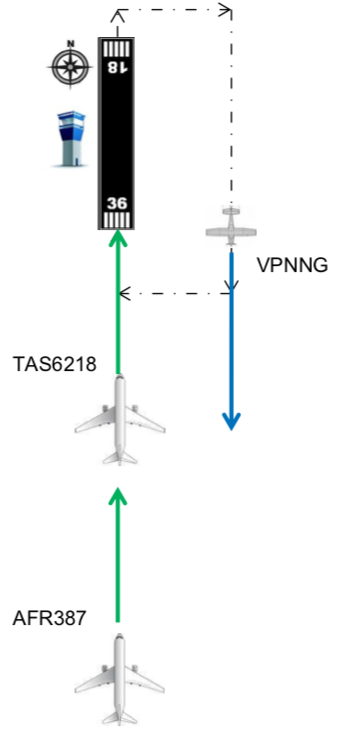
- 📡 Lotus Flower 6 2 1 8, traffic Cessna 1 7 2 on right hand downwind, runway 3 6 cleared to land, wind calm
- ✈️ Cleared to land runway 3 6, traffic in sight, Lotus Flower 6 2 1 8
- 🛩️ End of right hand downwind runway 3 6, VPNNG
- 📡 VPNNG, extend downwind runway 3 6, traffic Airbus 3 3 0 long final runway 3 6
- 🛩️ Extend downwind runway 3 6, traffic in sight, VPNNG
At this time, the second IFR aircraft enters the tower controller area:
- ✈️ Tower, Air France 3 8 7, established ILS runway 3 6, 8Nm final
- 📡 Air France 3 8 7, number 2 behind airbus 3 3 0 on final runway 3 6, continue approach
- ✈️ Number 2, traffic in sight, continuing approach, Air France 3 8 7
Note: We must not give the landing clearance to the aircraft AFR387, due to the previous landing clearance given: the runway is reserved for TAS6218 landing. The runway will be available for landing when previous aircraft have vacated the runway on the ground or the runway axis after a going around procedure.
During the extended downwind manoeuvre, the VFR flight must maintain the airfield in sight with the runway all the time. Check current weather before giving this instruction.
If there is a regulation with more than 2/3 IFR flight, the extended downwind procedure is not adequate due to the fact that the extended downwind leg will be very long and the risk of losing visual will be very high.
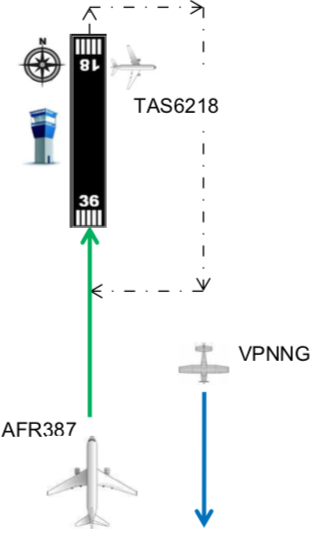
When the first aircraft (A330) is behind the VFR traffic, it's time to give other traffic information in order to make separation with the second IFR (AFR387):
- 📡 VPNNG, number 2, traffic Airbus 3 3 0 long final runway 3 6, report right hand base leg runway 3 6
- 🛩️ Number 2, traffic in sight, report right hand base leg runway 3 6, VPNNG
ㅤ
- 📡 Air France 3 8 7, traffic Cessna 1 7 2 right hand down wind, runway 3 6 cleared to land.
- ✈️ Runway 3 6 cleared to land, traffic in sight, Air France 3 8 7
Note: The VFR report on base leg will inform the controller that the VFR traffic will turn into the runway and does not continue on downwind. The tower controller will give further clearance in function of the situation at hand.
During an extended downwind manoeuvre, the VFR aircraft shall not leave the tower controller airspace. The controller shall ensure that any arriving VFR aircraft will fly inside the control zone or inside his area of responsibility.
¶ Orbit instruction
There are situations within your controlled area, as a tower controller, you cannot integrate one or several of your aircraft established on your aerodrome circuit due to the following reasons:
- Many IFR aircraft controlled by approach controller without sufficient space to integrate a VFR.
- Many aircraft to be cleared for taking off congested holding point)
- Too much traffic inside the aerodrome circuit
- Preceding slowing down traffic causing traffic congestion
- Emergency aircraft
- Preceding aircraft not in sight
In this case, the controller has no choice but to give a holding clearance to the aircraft which cannot continue on the present heading or current instruction or clearance.
Holding instruction for VFR traffic is an orbit clearance (i.e. making a 360° turn).
There are several locations for a VFR flight to hold:
- At VFR points published on charts
- Over a specific landmark in your area of responsibility as tower controller
- At downwind leg.
The orbit clearance will not be given on base leg or on final except for safety reasons.
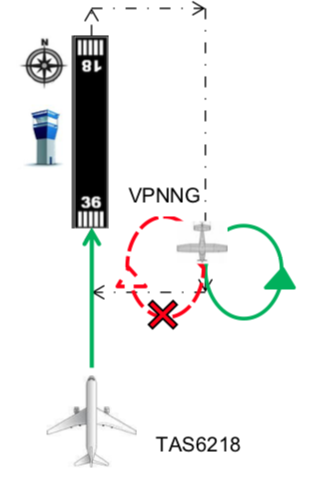
Example with two aircraft:
- TAS6218 is final runway 36 at 4NM DME
- VPNNG on end of downwind runway 36
- ✈️ Tower, Lotus Flower 6 2 1 8, established ILS runway 3 6, 4 NM final
- 📡 Lotus Flower 6 2 1 8, number one, traffic Cessna 1 7 2 on right hand downwind, runway 3 6 cleared to land, wind calm
- ✈️ Number one, traffic in sight, runway 3 6 cleared to land
As tower controller, you cannot integrate the C172 on final due to possible conflict (two aircraft arriving on final at the same time). In order to maintain enough separation, you can order the VFR flight to hold at the present position:
- 📡 VPNNG, traffic Airbus 3 3 0 long final runway 3 6, integration on final not possible, orbit by the left
on downwind runway 3 6 - 🛩️ Orbiting by the left on downwind runway 3 6, traffic in sight, VPNNG
Note: In this example, orbiting by the right is dangerous due to the proximity of the runway and landing traffics.
During the orbiting manoeuvre, the air traffic controller shall monitor that the orbiting aircraft will not move too close to another aircraft or to the runway axis.
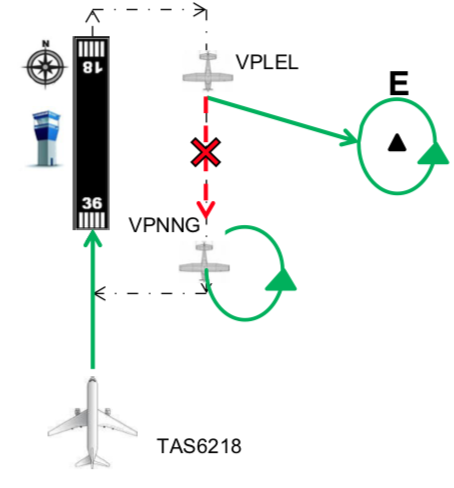
Example with two aircraft:
- TAS6218 is on final runway 36 at 4NM DME
- VPNNG on end of downwind runway 36 orbiting and holding on downwind.
- VPLEL at the beginning of downwind
- Letter E is a published VFR point on charts
At this present time, you cannot let aircraft VPLEL continue his flight on downwind leg in order to prevent making a stack of aircraft at downwind leg. At this stage, aircraft VPLEL shall quit the downwind in order to avoid collision and limit the number of aircraft holding near the runway.
- 📡 VPLEL, traffic Cessna 1 7 2 waiting on end of downwind runway 3 6, turn direct Echo and orbit by the
left at Echo - 🛩️ Direct Echo, Orbiting by the left at Echo, traffic in sight, VPLEL
¶ Traffic not in sight! Some tips
In some situation, you will give traffic advisories to inbound traffic and the answer of the pilot will be: "traffic not in sight".
If the incoming aircraft is far enough, you can let this traffic continue and await the "traffic in sight" report. But there is some situation that separation cannot be maintained due to the fact the second pilot does not see the preceding aircraft.
The reasons for not seeing traffic can be:
- Poor visibility (controller can anticipate by checking METAR information)
- A cloud between two aircraft so that the controller cannot anticipate this situation
- A network problem or a software (MTL,CSL) issue as a result of which the flight simulator software does not display the traffic
- Pilot has "bad" eyes and cannot determine the exact position of the traffic
- Traffic is too far and pilot does not see the traffic
This situation can occur many times with random occurrence. The controller must be prepared to handle this type of situation.
The basic solution of this situation is to instruct the pilot to hold near a strategic point. A pilot who cannot see any traffic shall be handled like he is alone in the air; you must provide him sufficient space behind preceding traffic in order to prevent collision.
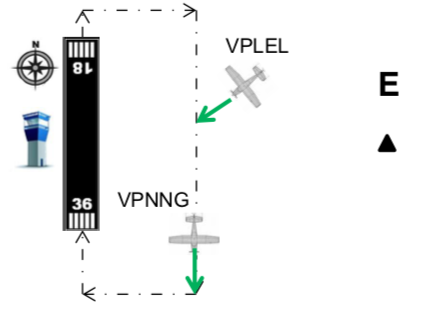
Example with two aircraft:
-
VPNNG on end of downwind runway 36
-
VPLEL at the middle of downwind
-
Letter E is a published VFR point on charts
-
📡 VPLEL, join middle of right hand downwind runway 3 6, number 2 behind Cessna 1 7 2 at end of downwind runway 3 6, report downwind
-
🛩️ Will join middle of right hand downwind Runway 3 6, number 2, traffic not in sight, will report downwind, VPLEL
-
📡 VPLEL, report traffic in sight
-
🛩️ Wilco
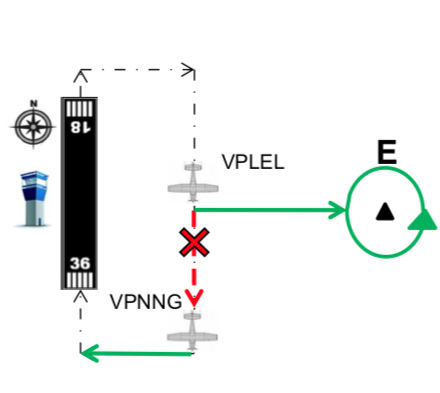
If there is enough separation between two aircraft, the tower controller can let the aircraft integrate on downwind. With that, the tower controller gives the aircraft more time to look around in order to find the traffic:
- 🛩️ On right hand downwind sight, VPLEL
- 📡 VPLEL, confirm Cessna 1 7 2 on right hand downwind in sight?
- 🛩️ Traffic not in sight, VPLEL
You cannot let aircraft VPLEL continue his flight on downwind leg when he cannot ensure his separation with the traffic ahead (traffic not in sight). At this stage, aircraft VPLEL shall leave the downwind in order to prevent collision and ensure safe operations near the runway.
- 📡 VPLEL, turn direct Echo and orbit by the left at Echo
- 🛩️ Direct Echo, Orbiting by the left at Echo, VPLEL
In function of traffic localization, you can give an orbit instruction outside the aerodrome circuit when necessary. This instruction can be given before aircraft integration if the separation is not compatible with the situation.
¶ Conflict management
¶ IFR "pushing VFR"
Sometimes as tower controller, you will face a situation that a slow VFR aircraft is on long final and needs some minutes to land and behind him there is an IFR aircraft which is only 3 to 5 NM behind.
In order to avoid a probable go around for IFR, it is sometimes necessary to give a go around clearance to the VFR aircraft to let IFR aircraft land without delay.
There is no "IFR" priority over "VFR" in the regulation but, when an IFR aircraft is going around, it will lose about 15 minutes minimum flying time to re-join the final again. The same go around clearance given to the VFR traffic will lose about 5 minutes flying time only. In the real world, the efficiency is better in the second case to give a go around and new integration instructions to the VFR aircraft.
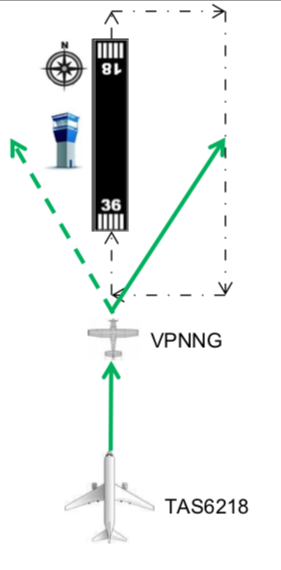
Example:
- The A330 is established on final 36
- The C172 is on final runway 36
- ✈️ Tower, Lotus Flower 6 2 1 8, established ILS runway 3 6, 6 NM final
- 📡 TAS6218, number 2, behind Cessna 1 7 2 short final runway 3 6, continue approach runway 3 6
At this stage, the tower controller must evaluate the situation and answer the question: "Does VFR traffic have time to land and vacate the runway before the IFR aircraft will arrive on short final (<2NM)". If the answer is no, a go around shall be given to one of the aircraft without delay.
In this situation the tower controller gives a go around clearance to the VFR aircraft:
- 📡 VPNNG, due to traffic Airbus 3 3 0 on final, go around runway 3 6, wind 040° 5 knots, report right hand downwind runway 3 6
- 🛩️ Going around runway 3 6, will report right hand downwind runway 3 6, VPNNG
Note: If there is traffic on downwind that makes any VFR integration on the aerodrome circuit difficult, the go-around can be instructed on the other side.
¶ Aircraft on short final runway not vacated
Sometimes as tower controller, you will face a situation that an aircraft on short final (less than 2NM from runway threshold) and the runway is still occupied (not vacated).
You cannot give any landing clearance to an aircraft when the runway is occupied (aircraft, ground vehicles, animals, persons ....).
Any pilot on short final can decide himself, without any coordination with controller, to make a go around if he sees that the runway is not cleared.
As tower controller if there is an aircraft on short final (less than 2NM from runway threshold), you shall give without delay a go around clearance, except if you initiate a negotiation with the pilot in command in order to give a "late landing clearance" just before the runway threshold.
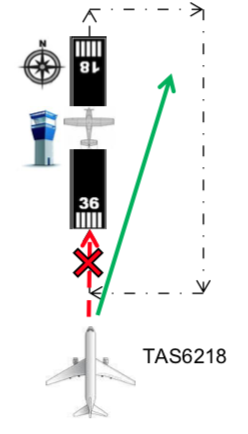
Example:
- The A330 is established on ILS runway 36
- The C172 is on final runway 36
- 🛩️ Tower, Lotus Flower 6 2 1 8, established ILS runway 3 6, 6 NM final
- 📡 Lotus Flower 6 2 1 8, number 2, behind Cessna 1 7 2 short final runway 3 6, continue approach runway 3 6
After a while, you will obtain the situation showed at the left:
- The A330 is on short final 36, 2NM
- The C172 is still on runway 36
- 📡 Lotus Flower 6 2 1 8, runway not vacated, go around runway 3 6, wind 050° 7knots
- ✈️ Going around runway 3 6, Lotus Flower 6 2 1 8
Note: Tower controller shall also when possible inform the VFR pilot that he has to vacate the runway as soon as possible due to traffic on final.
¶ Departure impacts on aerodrome circuit
The departure flow should be handled in the order in which they are ready for take-off.
But, there are several factors that can modify a pre-determined departure sequence:
- Presence of different types of aircraft (IFR, VFR)
- Category of aircraft (Light, Medium or Heavy) for wake turbulence separation
- Departure route
- Priority aircraft
- Traffic presence in some areas
- Landing aircraft
Once a departure sequence has been established on the taxiway scheme, it can be difficult to change the pre-existing order.
When departing the traffic pattern, VFR aircraft should continue beyond the departure end of the runway after reaching pattern altitude using:
- straight out departure
- 45° left turn departure for left hand (right turn for right hand).
Pilots need to be aware of any traffic entering the traffic pattern prior to starting a turn; traffic information is vital to complete the operation safely.
In some cases, a straight out or 45° departure will not be possible. The tower controller can use the downwind leg as an initial safe departure before continuing to the destination airfield.
¶ 45° departure
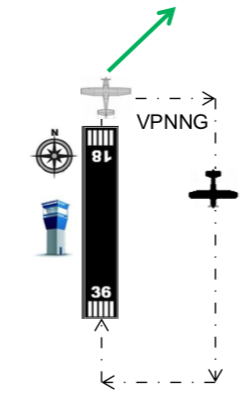
- 📡 VPNNG, runway 3 6 cleared for take-off, wind calm, fly a 45° departure, information at your 4 o'clock, Cessna 1 7 2 on right hand downwind at 1500ft
- 🛩️ Runway 3 6 cleared for take-off, wind calm, we will fly a 45° departure, traffic in sight, VPNNG
¶ Straight-Out departure
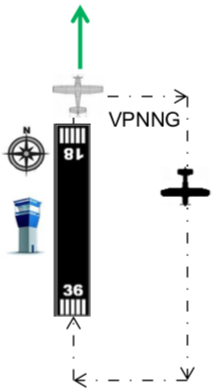
- 📡 VPNNG, runway 3 6 cleared for take-off, wind calm, fly a straight-out departure, information at your 4 o'clock, Cessna 1 7 2 on right hand downwind at 1500fts
- 🛩️ Runway 3 6 cleared for take-off, wind calm, we will fly a straight-out departure, traffic in sight, VPNNG
¶ Departure after establishing a downwind
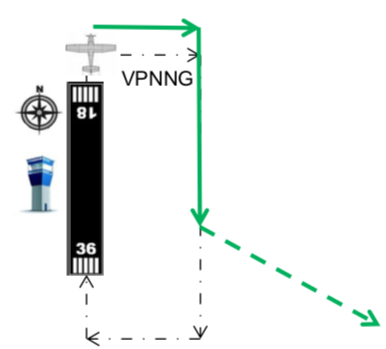
- 📡 VPNNG, runway 3 6 cleared for take-off, wind calm, report middle of right hand downwind
- 🛩️ Runway 3 6 cleared for take-off, will report middle of right hand downwind, VPNNG
After a while:
- 🛩️ Middle of right hand downwind runway 3 6, VPNNG
- 📡 VPNNG, leave the control zone at south-east, climb 2000ft
¶ Traffic priorities
The tower controller should be aware that priorities will exist under certain conditions. It is important to evaluate all the factors and determine if these situations could affect the traffic flow and its safety.
Flight priority shall be given to:
- Aircraft in emergency and in distress situation (MAYDAY) that needs immediate landing (fire...)
- Aircraft in emergency but not in distress, aircraft have margin to land but low delay for landing is required (low fuel, potential distress expected by the pilot in command...)
- Hospital aircrafts or any aircraft carrying any injured or sick person requiring urgent medical attention
- Aircrafts under safe and rescue operations
- Aircrafts in PAN situation. The aircraft can fly some minutes with no risk of immediate distress
It is important to know that an aircraft landing or in the final stage of an approach to land, normally, will have priority over an aircraft intending to depart from the same runway. In the aerodrome circuit, if there is no specific case like the examples above, the priority shall be:
- Landing clearances (full stop landing) and going-around clearance due to runway not clear
- Taking-off clearances
- VFR exercise clearance using the runway like touch and go, low pass or stop and go
- Instruction for traffic inside aerodrome circuit
- Instruction for traffic outside aerodrome circuit including circuit integration instruction
- Instruction to aircraft at holding point
- Instruction to aircraft on ground
¶ Use of radar / IVAO ATC software
With IVAO ATC software software, IVAO provides the use of radar coverage. The tower controller's primary function with radar is to visually scan the airport and local area.
With using radar information, the controller should enhance the efficiency of the tower control.
Radar information is not intended to provide radar services at tower level.
The tower controller can use the radar information:
- To determine an aircraft's exact location.
- To evaluate the separation between all aircraft
- To confirm a position report from a pilot
- To provide a suggested heading to help lost aircraft
- To help aircraft in emergency
- To provide assistance to all pilots on their request
- To provide traffic information
The tower controller shall never use the radar information:
- To provide radar vectors (except for emergency aircraft or lost aircraft assistance)
- To provide approach and/or departure control
- To provide en-route control
- None
- ICAO Documentation 4444 - Air Traffic Management - 16th Edition 2016 - Chapter 7.7
- VID 150259 - Creation
- VID 450012 - Wiki Integration
- VID 496402 - Wiki.js integration